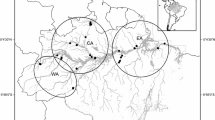Abstract
Eichhornia azurea and E. crassipes are the most frequent dominants of aquatic vegetation in the floodplain of the Upper Rio Paraná in Brazil. Morphological traits of samples collected at sites where they dominated the vegetation were measured and compared between vegetation types identified in the floodplain. Total leaf weight, specific leaf area and the leaf to root weight ratio of E. azurea and total leaf dry weight, total leaf area and total plant dry weight of E. crassipes differed significantly between vegetation types from 1999. Pearson correlation coefficients indicated a number of significant relationships between morphological traits and environmental variables. Five E. azurea traits increased linearly with water depth and four with water clarity. The leaf to root weight ratio also increased linearly with sediment iron and calcium content. E. crassipes total root dry weight and total plant dry weight were respectively quadratically related to sediment calcium and the euphotic proportion of the water column. Total leaf dry weight and total plant dry weight increased linearly with water depth while remainder dry weight decreased linearly with sediment phosphorus content.
Similar content being viewed by others
References
A. A. Agostinho M. Zalewski (1996) Planície alagável do Alto Rio Paraná: Importância e preservação (Upper Paraná River floodplain: importance and preservation). Editora Universidade Estadual de Maringá Maringá State University Publisher Maringá, Brazil 100
A. A. Agostinho S. M. Thomaz C. V. Minte-Vera K. O. Winemiller (2000) Biodiversity in the high Paraná river floodplain B. Gopal W. J. Junk J. A. Davis (Eds) Biodiversity in Wetlands: Assessment, Function and Conservation, 1 Backhuys Publishers Leiden, The Netherlands 89–118
R. F. Benassi A. F. M. Camargo (2000) ArticleTitleAvaliação do processo competitivo entre duas espécies de macrófitas aquáticas flutuantes, Pistia stratiotes L. e Salvinia molesta D. S. Mithcell Revista de Iniciação Científica 1 59–66
L. M. Bini (1996) ArticleTitleInfluence of flood pulse on the fitomass of three species of aquatic macrophytes in the Upper River Paraná floodplain Archives of Biology and Technology 39 IssueID3 715–721
A. F.M. Camargo F.A. Esteves (1996) ArticleTitleInfluence of water level variation on biomass and chemical composition of the aquatic macrophyte Eichhornia azurea (Kunth.) in an oxbow lake of the rio Mogi-Guaçu (São Paulo, Brazil) Archiv für Hydrobiologie 135 423–432 Occurrence Handle1:CAS:528:DyaK28Xht1Oru74%3D
B. Gopal (1987) Water Hyacinth Elsevier Amsterdam, The Netherlands 471
M. O. Hill (1979) TWINSPAN – A FORTRAN Program for Arranging Multivariate Data in an Ordered Two-Way Table by Classification of the Individuals and Attributes Section of Ecology and Systematics Cornell University. Ithaca, New York
W. J. Junk P. B. Bayley R. E. Sparks (1989) ArticleTitleThe flood pulse concept in river-floodplain systems In Proceedings of the International Large Rivers Symposium Canadian Special Publication of Fisheries and Aquatic Sciences 106 110–127
K. J. Murphy G. Dickinson S. M. Thomaz L. M. Bini K. Dick K. Greaves M. Kennedy S. Livingstone H. McFerran J. Milne J. Oldroyd R. Wingfield (2003) ArticleTitleAquatic vegetation of the Upper Rio Paraná floodplain in Brazil: a functional analysis Aquatic Botany 77 257–276 Occurrence Handle10.1016/S0304-3770(03)00108-6
J. J. Neiff (1986) Aquatic plants of the Paraná system B. R. Davies K. F. Walker (Eds) The Ecology of River Systems Dr W. Junk Publishers Dordrecht, The Netherlands 557–571
M. A. L. Rubim A. F. M. Camargo (2001) ArticleTitleTaxa de crescimento específico da macrófita aquática Salvinia molesta Mitchell em um braço do Rio Preto, Itanhaém, São Paulo Acta Limnologica Brasiliensia 13 IssueID1 75–83
R. E. D. Snowden B. D. Wheeler (1993) ArticleTitleIron toxicity to fen plant species The Journal of Ecology 81 35–46 Occurrence Handle1:CAS:528:DyaK3sXisV2nur0%3D Occurrence Handle10.2307/2261222
S. M. Thomaz M. C. Roberto L. M. Bini (1997) Caracterização limnológica dos ambientes aquáticos e influência dos níveis fluviométricos A. E. A. M. Vazzoler A. A. Agostinho N. S. Hahn (Eds) A Planície de Inundação do alto rio Paraná: Aspectos Físicos, Biológicos e Socioeconômicos Editora da Universidade Estadual de Maringá Maringá, Brazil 73–102
S. M. Thomaz T. A. Pagioro L. M Bini K. J. Murphy (2002) ArticleTitleEffect of reservoir drawdown on biomass of three species of aquatic macrophytes in a large sub-tropical reservoir (Itaipu, Brazil) Proc. 11th EWRS Internat. Symp. Aquatic Weeds, Moliets-Maâ France 2002 197–200
J. V. Ward J. A. Stanford (1995) ArticleTitleEcological connectivity in alluvial river ecosystems and its disruption by flow regulation Regulated Rivers –Research and Management 11 105–119
Author information
Authors and Affiliations
Corresponding author
Rights and permissions
About this article
Cite this article
Milne, J.M., Murphy, K.J. & Thomaz, S.M. Morphological variation in Eichhornia azurea (Kunth) and Eichhornia crassipes (Mart.) Solms in relation to aquatic vegetation type and the environment in the floodplain of the Rio Paraná, Brazil. Hydrobiologia 570, 19–25 (2006). https://doi.org/10.1007/s10750-006-0157-5
Issue Date:
DOI: https://doi.org/10.1007/s10750-006-0157-5




